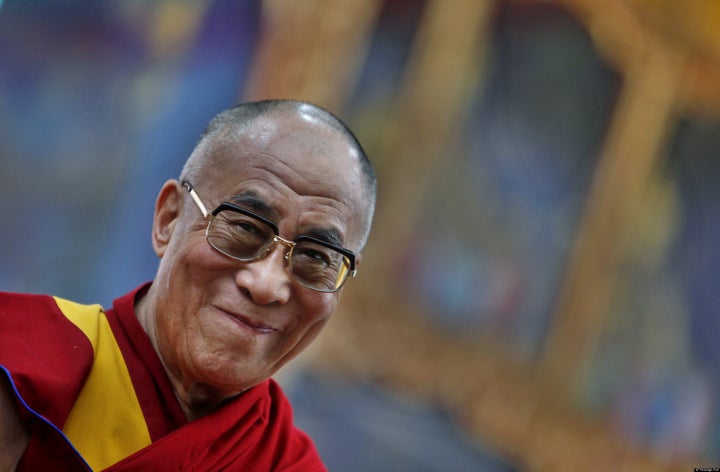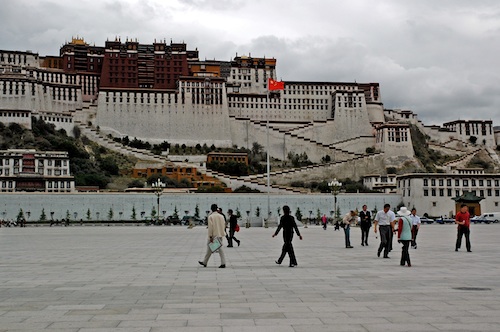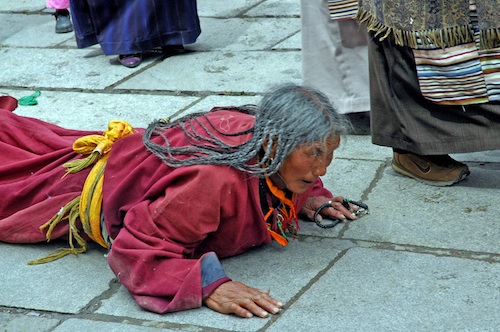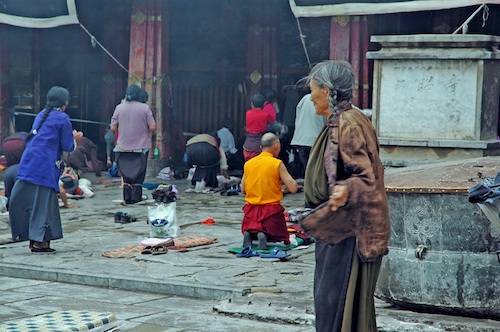
Lhasa is a city of contradictions. While this is Tibet's holiest city -- home to Jokhang Temple, which houses a 2,500-year-old statue of the Buddha that was carved during his lifetime, and the Potala Palace, the winter residence of the Dalai Lamas -- it is also home to massage parlors, thousands of prostitutes, and a very noticeable Chinese military presence.

My daughter and I visited Lhasa in July 2006 just days before the first train was due to arrive from Beijing. As we traveled down the main road, we passed the city's kitschiest landmark -- a golden yak statue. It's been inexplicably placed in the middle of the road, creating the only traffic circle we saw for thousands of miles. Looking beyond the yak, we gazed at the incredible red and white, thousand-room Potala Palace, built into the top of Red Mountain, which the city now surrounds. Across from the palace is a broad plaza with a 100-foot-tall monument commemorating the 50th anniversary of the Peaceful Liberation of Tibet. We stopped to take a closer look, but a fence prevented us from getting too close. We looked back across the expanse of the plaza and noticed the large red flag of the People's Republic of China flapping in the wind, standing between the palace and us.

There was constant movement in front of the palace gate as pilgrims circumambulated the base of Red Mountain in a clockwise direction. Every Tibetan hopes to make a trip to Lhasa once in his lifetime to visit the Jokhang Temple and the Potala Palace, and to make several holy circumambulations. Some pilgrims choose to prostrate themselves the entire length of the journey, sometimes hundreds of miles, and resemble human inchworms as they creep ever closer to their holy destination.

Hundreds of Tibetans were prostrating themselves in front of the palace gate the morning we visited, some with rags tied around their hands to make it easier to slide forward. Those who weren't prostrating were walking and twirling a prayer wheel -- a silver wheel on a stick -- in a clockwise motion and chanting om mani padmeh hom. Visiting the holy sites doesn't guarantee enlightenment, but it does allow one to build up good karma to aid in one's reincarnation. As we watched the pilgrims, I asked our Tibetan guide what they thought of the train. "They don't think about it," he said. "It doesn't have anything to do with them."

Tibet has a long, complicated political history filled with off-and-on alliances with Mongolia, Nepal, India, Bhutan, and China. Potala Palace was first built in the 7th century by the 33rd king of Tibet and became the seat of religious and political power when the Dalai Lamas took up residence there. It was rebuilt and expanded in the 17th century by the fifth Dalai Lama, who was the first Dalai Lama to be buried at Potala Palace, which remains the traditional burial ground for Dalai Lamas (the current Dalai Lama is the 14th). Remarkably, this landmark, along with the Jokhang Temple, was spared during the Cultural Revolution, although thousands of monasteries and temples throughout Tibet were destroyed. Only 20 of the 1,000 rooms in the palace are open to the public, and there's speculation that many of the remaining rooms have been looted, their relics shipped off to China.
Inside the palace, we climbed up and down stairs that were often no more than ladders placed against walls. The small chapels displayed golden Buddhas, three-dimensional mandalas made from gold, and the enormous burial tombs of the Dalai Lamas, made of gold and inlaid with turquoise and coral. The chapel walls were covered with frescoes and every surface was either carved or brightly painted. The floor is made of arga -- about six inches of mud mixed with stones (some semi-precious) that is then tamped down and coated with canola oil.
Yak butter lamps and juniper incense burned in every room, creating a cloyingly sweet-smelling smoke. We were surrounded by pilgrims who carried offerings of melted yak butter in thermoses or solid yak butter in plastic bags, and at each lamp -- just an open bowl with floating wicks -- they added some of their own butter. The wicks sputtered and spit and the floor and walls were slick with grease. My daughter spotted a wild-eyed young monk in a filthy, torn robe with long hair and a scraggly beard, and she asked Tashi what his story might be. "Oh, he probably just came out of a cave where he spent months alone," he replied. In one chapel, a monk sat on a low bench while a cat and her kittens played nearby, important residents for keeping the rat population in check since the monks' faith forbids them from killing any living thing.
The Potala Palace once housed thousands of monks, but when we visited only 73 lived there. Chinese security guards in shiny black uniforms with walkie-talkies made their way through the crowd, ready to grab anyone who dared to take a photo.
A cynic might think that the Qinghai Tibet train, which was due to arrive in Lhasa two days after we left, might be a convenient way to bring more Han Chinese settlers to the region along with the 4,000 visitors that will be dumped into Lhasa every day -- in fact, the 2008 uprising in Lhasa might be testimony to this fact. This train could also take more resources out of the country. On the other hand, an optimist might think the Chinese have pushed the railroad to Tibet because they want to present this gem of a culture to the world. Maybe China recognizes this unreachable, unknowable place as a desirable tourist destination, and that will spare the Tibetan culture. Whatever the motivation, recent Tibetan history will one day certainly be divided into the time before the train and the time after the train.
****